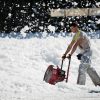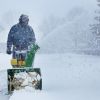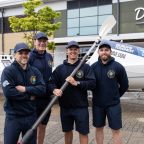
5 Must Know Facts About Snowblowers
Whether it brings you joy or dread, snow is pretty much an inevitable winter destiny. While it’s usually a delight to see the earth covered in a blanket of white snow, it becomes much less glamorous when you open your front door to find 12 inches of heavy snow flooding your driveway and you have no idea how to move it. This is where snow blowers come in handy.
A good snow blower can do the heavy lifting for you and effectively save you time, energy, and excruciating back pain. However, with the huge selection of models and the overwhelming array of features, choosing the right one can be a daunting task, there are a lot of things to consider when buying a snow blower.
Below, we’ve compiled a list of 5 facts that you must know before you make your purchase.
1 - Nonstick Cooking Oil Can Improve Your Snow Blower’s Performance
As bizarre as it may sound, nonstick cooking oil can effectively increase the throwing distance of your snow blower, allowing you to throw the snow further away from your driveway. The concept behind this simple hack is that in order for your snowblower to throw snow farther, there needs to be virtually no resistance inside the chute. By lubricating the inside of the chute, the fan, and all the auger parts with nonstick cooking spray, you can reduce the resistance in the chute and offer a slippery, smooth surface of the snow to flow steadily without sticking. This consequently maximizes the efficiency and performance of your machine.
2 - Single-Stage Snow Blowers Are For Short, Flat Driveways
Single-stage gas and electric snow blowers are typically lighter, more compact, and easier to handle than their two-stage counterparts. However, in wet, heavy snowfall or large accumulations of snow, they can become clogged or even break down. So if you live in a city where you frequently have to battle heavy snowfall, you’ll probably want something a bit more heavy-duty. But for those who live in a suburban area and need to clear moderate amounts of snow only a few times every winter, single-stage snow blowers are the way to go.
The gas single-stage models are most suitable for average-sized, flat driveways and sidewalks where the snowfall is below 8 inches deep while the electric models are more appropriate for shorter surfaces where the snowfall is less than 4 inches in thickness.
3 - Two-Stage Snow Blowers Are For Larger Expanses of Snow
While single-stage models simply suck up the snow and throw it out, most of them aren’t powerful enough to handle high volumes of packed snow. Two-stage snow blowers, on the other hand, outperform with kinds of their single-stage counterparts in every aspect. The distinct difference between the two models is that two-stage models throw the snow twice.
First, these powerful machines use the collection augers to break apart and scoop up the heavy, wet snow and the rock-solid ice. Then, a high-speed impeller discharges it through the throw chute to keep the snow moving, preventing it from clogging the intake bucket. Many two-stage models feature larger, rotating chutes, which makes them even more perfect for large snowdrifts. And pretty much all two-stage snow blowers are fitted with larger wheels and higher ground clearance, making them ideal for cleaning uneven terrains far more efficiently. They can also be used on gravel and concrete without ever slowing down.
4 - Three-Stage Snow Blowers Are For Hardcore Snow Removal
Currently, three-stage snow blowers are the most powerful and efficient models on the market. These models have numerous advanced features that aim to make the time you spend removing snow, both easy and comfortable. Some of the most prominent features on these models include self-propelled wheels, single-press chute control, and heated grips, but the main reason why these snowblowers are so popular is because of their unmatched ability to remove any kind of snowfall from any kind of terrain.

Three-stage snow blowers are fitted with a third auger that runs parallel to the collection augers. First, the two augers scoop up the ice and snow, then the third auger crushes it into slush that’s discharged out of the chute at high speed. Now, you might be thinking “This is exactly what two-stage blowers do, but with the exception of the third auger” Well, you’re not wrong. However, three-stage snow blowers are many steps ahead of their two-stage counterparts in terms of speed and efficiency. If you tend to freeze walls of snow at the end of your driveway, this machine can plow through heaps of snow as high as 20 inches or more and launch them 50 feet away from your driveway in just a matter of seconds.
5 - It Matters How You Store Your Snow Blower
Improperly storing your snowblower during the off-seasons can give you grief in the coming winter if it snows without warning. To avoid the headache, always drain the fuel from the tank at the end of the snow blowing season. Storing fuel for a long time in any type of gas engine causes corrosion and gunk to build up inside the tank which can make it extremely challenging to clean your carburetor, replace the fuel lines, or even start the engine. Also, to protect your battery and engine, never leave the key in the ignition switch when storing your snowblower for longer than 30 days. As you can see, a lot of things come into play when choosing a snowblower that will see you through many winters to come. The size of your property or the surface you need to clear, the average snow accumulation in your area, and how often you’ll be using your snowblower are all important factors to consider.
Don’t risk your back or your sanity again this winter. The right snow blower can make almost any blizzard easy to tackle, and even a little fun too. With these facts in mind, you’ll be well equipped to face the winter.You can finally say goodbye to back pain and blistered hands because these machines will make your life a lot easier.


















